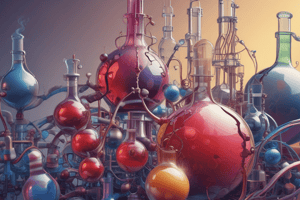Podcast
Questions and Answers
What is the most important method for the preparation of alkanes mentioned in the text?
What is the most important method for the preparation of alkanes mentioned in the text?
- Catalytic Hydrogenation of Alkenes (correct)
- Electrophilic Addition to Alkenes
- Hydrolysis of Grignard reagent
- Reduction of alkyl halides
What type of bond in alkenes is relatively weak and reactive?
What type of bond in alkenes is relatively weak and reactive?
- Covalent bond
- Ionic bond
- Pi (π) bond (correct)
- Sigma (σ) bond
What is the purpose of a catalyst in a chemical reaction?
What is the purpose of a catalyst in a chemical reaction?
- It increases the rate of the reaction (correct)
- It consumes itself in the reaction
- It changes the reactants
- It decreases the rate of the reaction
Which type of compounds have one or more hydrogen atoms in an alkane replaced by halogen atoms?
Which type of compounds have one or more hydrogen atoms in an alkane replaced by halogen atoms?
What is the generic formula of a Grignard reagent?
What is the generic formula of a Grignard reagent?
Which method involves converting alkenes into alkanes using a small amount of catalyst and hydrogen gas?
Which method involves converting alkenes into alkanes using a small amount of catalyst and hydrogen gas?
What is the general formula for the Grignard reagent?
What is the general formula for the Grignard reagent?
What metal is commonly used in the preparation of the Grignard reagent?
What metal is commonly used in the preparation of the Grignard reagent?
Which method involves the replacement of a halogen atom in an alkyl halide with a hydrogen atom?
Which method involves the replacement of a halogen atom in an alkyl halide with a hydrogen atom?
What is the carbon skeleton like after the reduction of an alkyl halide?
What is the carbon skeleton like after the reduction of an alkyl halide?
Which compound is formed when a Grignard reagent reacts with water?
Which compound is formed when a Grignard reagent reacts with water?
What is the main characteristic of organometallic reagents, like the Grignard reagent, mentioned in the text?
What is the main characteristic of organometallic reagents, like the Grignard reagent, mentioned in the text?
What effect does the higher electronegativity of carbon compared to magnesium have on the carbon atom in the Grignard reagent?
What effect does the higher electronegativity of carbon compared to magnesium have on the carbon atom in the Grignard reagent?
What is electronegativity a measure of, according to the text?
What is electronegativity a measure of, according to the text?
Which method mentioned in the text is unique in forming carbon-carbon bonds and generating a new, larger carbon skeleton?
Which method mentioned in the text is unique in forming carbon-carbon bonds and generating a new, larger carbon skeleton?
What do organolithium reagents react with cuprous iodide to form, as discussed in the text?
What do organolithium reagents react with cuprous iodide to form, as discussed in the text?
In the context of organometallic chemistry, what role do Grignard reagents typically serve?
In the context of organometallic chemistry, what role do Grignard reagents typically serve?
What is the primary purpose of using Gilman reagents in organic synthesis?
What is the primary purpose of using Gilman reagents in organic synthesis?
Which of the following statements is true about R'X in the synthesis using Gilman reagents?
Which of the following statements is true about R'X in the synthesis using Gilman reagents?
What role does cuprous halide (CuX) play in the formation of alkyl lithium?
What role does cuprous halide (CuX) play in the formation of alkyl lithium?
What happens to the alkyl group R during the reaction involving Gilman reagents?
What happens to the alkyl group R during the reaction involving Gilman reagents?
Which statement best describes the formation of organolithium reagents?
Which statement best describes the formation of organolithium reagents?
Why is it essential for R'X to be a primary halide for good yields in the synthesis process?
Why is it essential for R'X to be a primary halide for good yields in the synthesis process?
Gilman reagents are formed by reacting alkylhalides with lithium metal.
Gilman reagents are formed by reacting alkylhalides with lithium metal.
To synthesize an alkane with a higher carbon number, it is necessary to form carbon-oxygen bonds.
To synthesize an alkane with a higher carbon number, it is necessary to form carbon-oxygen bonds.
In the formation of alkyllithium, cuprous iodide is added first before the alkyl halide.
In the formation of alkyllithium, cuprous iodide is added first before the alkyl halide.
The alkane is ultimately synthesized from three alkyl halides.
The alkane is ultimately synthesized from three alkyl halides.
Gilman reagents require that R'X should be a tertiary halide for good yields.
Gilman reagents require that R'X should be a tertiary halide for good yields.
In the reaction involving Gilman reagents, the alkyl group R is transferred from zinc.
In the reaction involving Gilman reagents, the alkyl group R is transferred from zinc.
Evidence strongly suggests that the mechanism of Gilman reagents involves electrophilic aromatic substitution.
Evidence strongly suggests that the mechanism of Gilman reagents involves electrophilic aromatic substitution.
Organolithium reagents react with cuprous iodide to form alkyl lithium.
Organolithium reagents react with cuprous iodide to form alkyl lithium.
The general formula for a Grignard reagent is R-X.
The general formula for a Grignard reagent is R-X.
The role of cuprous halide (CuX) in forming alkyl lithium is to act as a catalyst.
The role of cuprous halide (CuX) in forming alkyl lithium is to act as a catalyst.
Flashcards are hidden until you start studying




